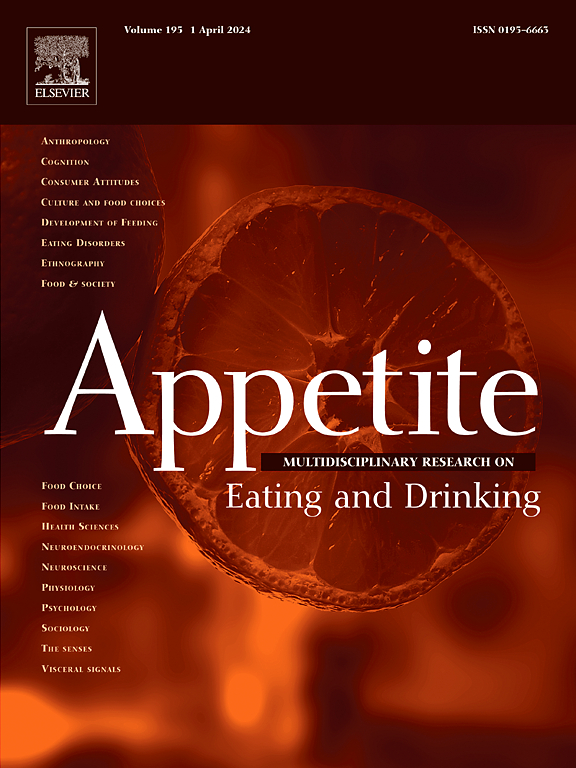食物素养和饮食动机与饮食质量、一般性肥胖和腹部肥胖的关系:一项横断面研究。
IF 4.6
2区 医学
Q1 BEHAVIORAL SCIENCES
引用次数: 0
摘要
本横断面研究旨在调查饮食素养和饮食动机与饮食质量和肥胖的关系。参与者是1055名年龄在20-69岁之间的日本成年人。自我感知食品素养量表用于评估食品素养(食品准备技能、适应力和抵抗力、健康零食风格、社会和有意识的饮食、检查食品标签、日常食品计划、健康预算和健康食品储备)。饮食动机调查被用来评估饮食动机(喜好、习惯、需要和饥饿、健康、方便、快乐、传统饮食、自然关注、社交、价格、视觉吸引力、体重控制、影响调节、社会规范和社会形象)。饮食质量(健康饮食指数-2020)根据4天称重饮食记录进行评估。在调整潜在混杂因素后,较高的食物制作技能(β 0.64)、健康零食风格(β 1.62)、检查食品标签(β 0.72)、健康预算(β 0.71)和自然关注动机(β 0.75)得分和较低的便利动机(β -0.45)和快乐动机(β -0.62)得分与较高的饮食质量显著相关。相比之下,喜好动机(比值比1.32)和体重控制动机(比值比1.19)得分较高,适应力和抵抗力动机(比值比0.76)、日常饮食计划动机(比值比0.84)和健康动机(比值比0.67)得分较低,与腹部肥胖(男性腰围≥90 cm;女性≥80 cm);所有这些变量(日常饮食计划除外)也与一般肥胖(体重指数≥25 kg/m2)相关。总之,与饮食质量相关的饮食素养领域和饮食动机不同于与肥胖相关的。这些发现对改善饮食质量和对抗肥胖流行病的有效策略具有重要意义。本文章由计算机程序翻译,如有差异,请以英文原文为准。
Food literacy and eating motivation in relation to diet quality and general and abdominal obesity: A cross-sectional study
This cross-sectional study aimed to investigate the associations of food literacy and eating motivation with diet quality and obesity. Participants were 1055 Japanese adults aged 20–69 years. The self-perceived food literacy scale was used to assess food literacy (food preparation skills, resilience and resistance, healthy snack styles, social and conscious eating, examining food labels, daily food planning, healthy budgeting, and healthy food stockpiling). The Eating Motivation Survey was used to assess eating motives (liking, habits, need and hunger, health, convenience, pleasure, traditional eating, natural concerns, sociability, price, visual appeal, weight control, affect regulation, social norms, and social image). Diet quality (Healthy Eating Index-2020) was assessed based on 4-day weighed dietary records. After adjustment for potential confounders, higher scores for food preparation skills (β 0.64), healthy snack styles (β 1.62), examining food labels (β 0.72), healthy budgeting (β 0.71), and natural concerns motive (β 0.75) and lower scores for convenience (β −0.45) and pleasure (β −0.62) motives were significantly associated with a higher diet quality. In contrast, higher scores for liking (odds ratio (OR) 1.32) and weight control (OR 1.19) motives and lower scores for resilience and resistance (OR 0.76), daily food planning (OR 0.84), and health motive (OR 0.67) were significantly associated with a higher prevalence of abdominal obesity (waist circumference ≥90 cm for males; ≥80 cm for females); all of these variables (except for daily food planning) were also associated with general obesity (body mass index ≥25 kg/m2). In conclusion, the food literacy domains and eating motives associated with diet quality differed from those associated with obesity. The findings have important implications for effective strategies to improve diet quality and combat the obesity epidemic.
求助全文
通过发布文献求助,成功后即可免费获取论文全文。
去求助
来源期刊

Appetite
医学-行为科学
CiteScore
9.10
自引率
11.10%
发文量
566
审稿时长
13.4 weeks
期刊介绍:
Appetite is an international research journal specializing in cultural, social, psychological, sensory and physiological influences on the selection and intake of foods and drinks. It covers normal and disordered eating and drinking and welcomes studies of both human and non-human animal behaviour toward food. Appetite publishes research reports, reviews and commentaries. Thematic special issues appear regularly. From time to time the journal carries abstracts from professional meetings. Submissions to Appetite are expected to be based primarily on observations directly related to the selection and intake of foods and drinks; papers that are primarily focused on topics such as nutrition or obesity will not be considered unless they specifically make a novel scientific contribution to the understanding of appetite in line with the journal's aims and scope.
 求助内容:
求助内容: 应助结果提醒方式:
应助结果提醒方式:


